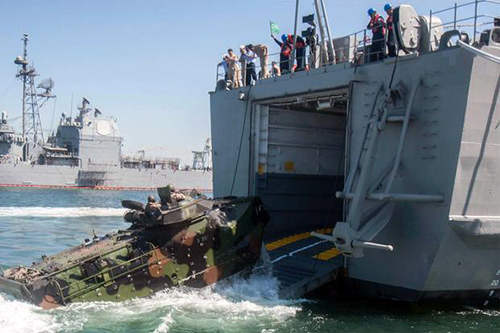The Director, Expeditionary Warfare Division (N75) asked us to assess the role of amphibious, maritime pre-positioning force, and tactical lift in the context of the U.S. Marine Corps ’ new concept for amphibious warfare, operational maneuver from the sea (OMFTS). The overall project is known as Relating Amphibious Lift to Forcible Entry. This report completes one task within the project, a historical assessment of amphibious operations, particularly as related to forc- ible entry and Marine Corps operational concepts. Specifically, we explain the rationale behind amphibious warfare, discuss the changes in amphibious warfare since 1941, and identify historical approaches to implementing operations that were similar to OMFTS. Thereby, we provide a general assessment of the relationship between OMFTS and historical reality.
The object of OMFTS is to increase the decisiveness of amphibious warfare. Historically, amphibious operations have been methodical and entailed substantial casualties to the attacker. OMFTS attempts to reverse this trend, partly through exploiting new technology, such as the MV-22 Osprey, the AAAV, and command and control systems. “Seamless” maneuver will replace the former process of securing and holding a beachhead, stabilizing a lodgment, building up supplies, and finally advancing toward the operational objective. Assault forces will deploy directly from the amphibious fleet against the inland operational objective. The period between landing and significant advance from the beachhead, known as the operational pause, will be minimized through sea basing. Rather than building up supplies ashore, the landing force will be supplied directly from the amphibi- ous fleet. Thereby, once the landing force has disembarked, it can advance rapidly rather than being tied to the lodgment while supplies are stockpiled. Optimally, OMFTS will comprise operations on a broad and deep front (extended front assaults). A naval expedition- ary force, located over the horizon, will deploy self-contained forma- tions of combined arms teams units along multiple axes of advance against the operational objective. Instead of the traditional assault on a 1-mile front with no depth, amphibious forces will operate on an approximately 200-n.mi. front (230 miles) and a 100-n.mi. or more depth (115 miles). Obliged to defend such a vast area, the defender will supposedly be unable to concentrate forces against the assault point.
Our historical assessment has three components. First, we reviewed the historical literature on amphibious warfare in order to determine the reasons that amphibious warfare has been implemented and to learn about its development since 1941. By doing so, we were able to compare the historical utility of amphibious warfare to the expected utility of operational maneuver from the sea. Second, we examined quantitative parameters of amphibious warfare in order to explore general trends relevant to the success of OMFTS. Third, we examined nine case studies to gain greater insight into the substance and context of amphibious assaults, particularly those exemplifying the tenets of operational maneuver from the sea. Through the case study analysis, we derived historical approaches for the successful implementation of OMFTS.
Our major argument is that the stated premises underlying the OMFTS warfighting concept, while largely sound, are incomplete. On the positive side, OMFTS laudably attempts to move away from the traditionally high casualties and methodical operational tempo of amphibious warfare. Several of its premises for doing so are histori- cally credible. Recent technological advances, from helicopters to information technology, have increased the potential for decisive amphibious operations since the Vietnam War. Furthermore, extend- ing the assault front historically presented the opportunity for the penetration and exploitation of enemy weak points. Moreover, OMFTS gives logistics well-deserved emphasis. We found that the supply buildup ashore has indeed been a cause of operational pause, if not the sole determinant. In fact, sea basing has historical roots as a remedy for operational pause.
Download reportApproved for Public Release; Distribution Unlimited. Specific authority: N0014-00-D-0700.
Details
- Pages: 116
- Document Number: CRM D0006297.A2/ Final
- Publication Date: 7/1/2002
